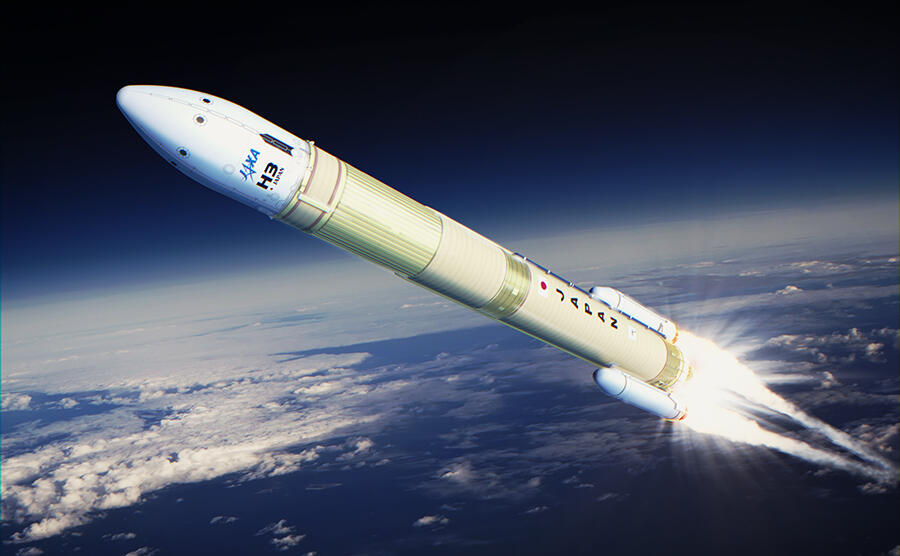Blog Credit: Trupti Thakur
Image Courtesy: Google
Next Gen H3 Rocket By Japan
On February 18th, 2023, the Japan Aerospace Exploration Agency (JAXA) announced the successful first orbital launch of its next-generation H3 launch vehicle. The new flagship rocket delivered its test payload into intended orbit after two prior failed launch attempts in 2022.
About H3 Rocket
The H3 rocket has been under development for over a decade by JAXA and Japanese manufacturer Mitsubishi Heavy Industries as a successor to the reliable H-IIA rocket used since 2001. It is designed for flexible and cost-effective satellite launches.
Unlike the reusable Falcon 9, the H3 is expendable, but scientists say the trial of its world-first technology is significant.
Advanced Capabilities
With high thrust and versatility to carry different payload configurations, H3 aims to secure Japan’s independent space access while competing globally as a rival to overseas commercial rockets like SpaceX’s Falcon 9. H3’s capabilities can cover full range of missions including cargo transport.
Maiden Flight Payloads
The rocket carried an advanced optical data relay satellite and an infrared observation microsatellite for detecting factory emissions during its test flight. Both were later confirmed as accurately separated into intended orbits by JAXA, validating launch performance.
Previous Launch Setbacks
High hopes from the H3 suffered after its first launch attempt in February 2022 was aborted at ignition. The second test flight in March 2022 also faced technical problems resulting in the rocket’s destruction after takeoff. Improvements were made subsequently.
Significance of Success
Achieving success in the ambitious maiden journey highlights JAXA’s perseverance and boosts Japan’s credibility as a competitive spacefaring nation with capacities across engineering, science and exploration.
Japan’s Growing Space Activity
The flawless H3 flight comes after recent feats like Japan’s SLIM probe successfully landing on lunar surface last month and plans for Mars moon sample return mission, underscoring its advancing space technology status.
Future Launch Applications
With flexibility to host differently sized satellites, the tested H3 is capable of launching future communications, observation and scientific missions. It promises cost-efficiency compared to overseas commercial launch options that Japan currently relies on.
All About H3 Rocket :
The H3 Launch Vehicle is a Japanese expendable launch system. H3 launch vehicles are liquid-propellant rockets with strap-on solid rocket boosters and are launched from Tanegashima Space Center in Japan. Mitsubishi Heavy Industries (MHI) and JAXA are responsible for the design, manufacture, and operation of the H3. The H3 is the world’s first rocket to use an expander bleed cycle for the first stage engine.
As of July 2015, the minimum configuration is to carry a payload of up to 4,000 kg (8,800 lb) into Sun-synchronous orbit (SSO) for about 5 billion yen, and the maximum configuration is to carry more than 6,500 kg (14,300 lb) into geostationary transfer orbit (GTO). The H3-24 variant will deliver more than 6,000 kg (13,000 lb) of payload to lunar transfer orbit (TLI) and 8,800 kg (19,400 lb) of payload to geostationary transfer orbit (GTO)(∆V=1830 m/s).
Development
Mitsubishi Heavy Industries supervised the development and manufacture of the H3 rocket’s airframe and liquid-fuel engines, while IHI Corporation developed and manufactured the liquid-fuel engine turbopumps and solid-fuel boosters, and Kawasaki Heavy Industries developed and manufactured the payload fairings. The carbon fiber and synthetic resin used for the solid fuel booster motor case and payload fairing were developed and manufactured by Toray.
The development of the H3 was authorized by the Japanese government on 17 May 2013. The H3 Launch Vehicle is being jointly developed by JAXA and Mitsubishi Heavy Industries (MHI) to launch a wide variety of commercial satellites. The H3 was designed with cheaper engines compared to the H-IIA, so that manufacturing the new launch vehicle would be faster, less risky, and more cost-effective. JAXA and Mitsubishi Heavy Industries were in charge of preliminary design, the readiness of ground facilities, development of new technologies for the H3, and manufacturing. The main emphasis in design is cost reduction, with planned launch costs for customers in the range of around US$37 million.
In 2015, the first H3 was planned to be launched in fiscal year 2020 in the H3-30 configuration (which lacks solid-rocket boosters), and in a later configuration with boosters in FY2021.
The newly developed LE-9 engine is the most important factor in achieving cost reduction, improved safety and increased thrust. The expander bleed cycle used in the LE-9 engine is a highly reliable combustion method that Japan has put into practical use for the LE-5A/B engine. However, it is physically difficult for an expander bleed cycle engine to generate large thrust, so the development of the LE-9 engine with a thrust of 1,471 kN (331,000 lbf) is the most challenging and important development element.
Firing tests of the LE-9 first-stage engine began in April 2017, with the first tests of the solid rocket boosters occurring in August 2018.
On 21 January 2022, the launch of the first H3 was rescheduled to FY 2022 or later, citing technical problems regarding the first stage LE-9 engine.
Vehicle description
The H3 Launch Vehicle is a two-stage launch vehicle. The first stage uses liquid oxygen and liquid hydrogen as propellants and carries zero, two or four strap-on solid rocket boosters (SRBs) (derived from SRB-A) using polybutadiene fuel. The first stage is powered by two or three LE-9 engines which uses an expander bleed cycle design similar to the LE-5B engine. The fuel and oxidizer mass of the first stage is 225 metric tons. The second stage is powered by a single engine which is an improved LE-5B. The propellant mass of the second stage is 23 metric tons.
Variants
Each H3 booster configuration has a two-digit plus letter designation that indicates the features of that configuration. The first digit represents the number of LE-9 engines on the main stage, either “2” or “3”. The second digit indicates the number of SRB-3 solid rocket boosters attached to the base of the rocket and can be “0”, “2”, or “4”. All layouts of the solid boosters are symmetrical. The letter at the end shows the length of the payload fairing, either short, or “S”, or long, or “L”. For example, an H3-24L has two engines, four solid rocket boosters, and a long fairing, whereas an H3-30S has three engines, no solid rocket boosters, and a short fairing. W-type fairing is similar to L-type except wider 5.4 m diameter. W-type was mentioned in the description of JAXA’s web page, but not in the current description as of November 2023.
As of November 2018, three configurations are planned: H3-30, H3-22, and H3-24.
A previously mentioned variant, the H3-32, was cancelled in late 2018 when the performance of the H3-22 variant, sporting one less engine on the core booster, was found to be greater than anticipated, putting it close to the H3-32’s performance. While the H3-32 would have provided greater performance, JAXA cited SpaceX’s experience with their Falcon 9 rocket, which routinely lifted commercial communications satellite payloads to less than the gold standard geostationary transfer orbit (GTO) of 1,500 m/s (4,900 ft/s) of delta-V remaining to get to geostationary orbit, leaving the satellites themselves to make up the difference. As commercial clients were apparently willing to be flexible, JAXA proposed redefining their reference transfer orbit to something lower, believing commercial clients would prefer the less expensive (if slightly less capable) H3-22 rocket, even if the client had to then load additional propellant onto their satellite for it to reach GEO, than a more expensive H3-32.
As of October 2019, MHI is considering contributing two variants for the Gateway project: an extended second stage variant, and the H3 Heavy variant which would comprise three first-stage liquid-fuel boosters strapped together, similar to Delta IV Heavy and Falcon Heavy. It would have a payload capacity of 28,300 kg (62,400 lb) to low Earth orbit.
Launch services
H3 will have a “dual-launch capability, but MHI is focused more on dedicated launches” in order to prioritize schedule assurance for customers.
As of 2018, MHI is aiming to price the H3 launch service on par with SpaceX’s Falcon 9.
Blog By: Trupti Thakur

19
FebNext Gen H3 Rocket By Japan
Feb 19, 2024Recent Blog
The BioMetric E-PassportsMay 19, 2025
AI HallucinationsMay 16, 2025
India’s Steps Into 6GMay 15, 2025
The New Accessibility Feature of AppleMay 14, 2025
The Digital Threat Report 2024May 13, 2025




